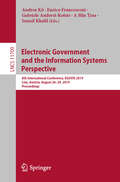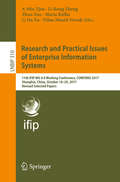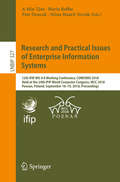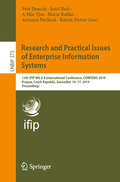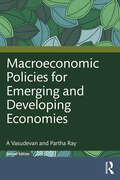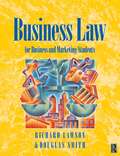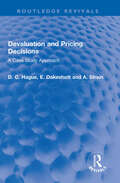- Table View
- List View
Cultural Olympians: Rugby School's Cultural Leaders
by John Clarke John Taylor Rowan Williams Jay Winter Anthony Kenny Ian Hesketh Andrew Vincent David Boucher John Witheridge David Urquhart Robin Poidevin A N Wilson A C Grayling Patrick DerhamThis book is designed to provide a rigorous yet practical engagement with key questions surrounding faith, philosophy, science, culture and social progress by celebrating the life and thought of Rugbeian cultural leaders, social pioneers and educationalists, with an exploration of their continued relevance to contemporary discussions. Some of the most distinguished historians, philosophers and social and religious commentators among them, including AN Wilson, John Clarke, AC Grayling, TH Green, Andrew Vincent and John Witheridge, here set out, argue and explore the most important values that guide and challenge us today.
The Growth of the Athenian Economy
by A FrenchFirst Published in 2005. Routledge is an imprint of Taylor & Francis, an informa company.
Get to Grips With Book Keeping
by A G PiperBookkeeping is neither dull nor mysterious - its rules are logical and straightforward and are readily mastered by practice. Get to Grips with Bookkeeping is a substantial yet easy to follow introduction to the principles of bookkeeping and the practical skills of recording transactions, posting the ledgers and preparing final accounts.Written by finance and accounting experts from the University of Birmingham this book:- Explains the purpose and use of books of original entry as the basis of the double-entry system.- Describes the processes of recording purchases, sales and cash transactions.- Shows how these records are used to prepare the final accounts - the manufacturing, trading and profit and loss accounts and the balance sheet - to provide accurate financial statements.- Explores petty cash, depreciation, partnership, company law, business documents and the effect of changes in IT.Worked examples throughout allow you to put the theory into practice. There is also a wide range of carefully graded questions and exercises with sample answers.In short, it demystifies the art of bookkeeping and gives you the confidence you need to tackle your books.NOT GOT MUCH TIME?One, five and ten-minute introductions to key principles to get you started.AUTHOR INSIGHTSLots of instant help with common problems and quick tips for success, based on the authors' many years of experience.TEST YOURSELFTests in the book and online to keep track of your progress.EXTEND YOUR KNOWLEDGEExtra online articles at www.teachyourself.com to give you a richer understanding of bookkeeping.TRY THISInnovative exercises illustrate what you've learnt and how to use it.
International Competitiveness, Investment and Finance: A Case Study of India (Routledge Studies in Development Economics #No.33)
by Kunal Sen A Ganesh-Kumar Rajendra VaidyaUsing India as a case study, this well-written, concise book covers everything one needs to know to understand how a country becomes internationally competitive. Showing that reforms that pertain to the real sector alone, such as industrial deregulation and trade reforms, are not enough to enhance a country's competitiveness, this book makes a compelling case for complimentary financial sector reforms.Of interest to academics studying international trade, industrial economics and development economics, this book is also guaranteed to be extremely useful for professional economists and those involved with policy making in developed and developing countries.
Introduction to the World Economy
by A J BrownWell constructed and thoroughly competent" - The Economist "It is refreshingly differentThe new-comer to economics who studies this book should find it an interesting and invigorating task" - Economic Journal This book introduces readers to some of the salient features and problems of the world economy and gives some indication of the main ways in which economists set about the task of analyzing them. After a general account of what economies are and how they work, the book's discussion develops with reference to broad statistical facts in relation to the following issues: why the world economy is as we find it; why productivity varies from one community to another; how prices are formed; how national economies have grown; what determines an economy's occupational structure; how local specialization comes about; how the pattern of international trade has grown and changed and what the main sources of insecurity in economic life are.
A Very Short, Fairly Interesting, Reasonably Cheap Book About... International Marketing
by A J EarleyConceived by Chris Grey, the Very Short, Fairly Interesting and Reasonably Cheap series offers an antidote to conventional textbooks. Each book takes a core area of the curriculum and turns it on its head by providing a critical and sophisticated overview of the key issues and debates in an informal, conversational and often humorous way. Looking beyond the usual colonial narrative of the subject, Amanda Earley encourages the reader to think reflectively and critically about overlooked aspects of International Marketing such as power relations, history, ethics, culture and politics. Examples are provided throughout with coverage of student-friendly brands such as Apple, Facebook and Google and their role in international marketing practices today. The author draws on history and the colonial era as well as illustrating the failure of American brands to break into other markets. There are also gritty, thought-provoking examples around racial divides in Asia and Australia. Need another "VSFI" book? Browse the series here
A Very Short, Fairly Interesting, Reasonably Cheap Book About... International Marketing
by A J EarleyConceived by Chris Grey, the Very Short, Fairly Interesting and Reasonably Cheap series offers an antidote to conventional textbooks. Each book takes a core area of the curriculum and turns it on its head by providing a critical and sophisticated overview of the key issues and debates in an informal, conversational and often humorous way. Looking beyond the usual colonial narrative of the subject, Amanda Earley encourages the reader to think reflectively and critically about overlooked aspects of International Marketing such as power relations, history, ethics, culture and politics. Examples are provided throughout with coverage of student-friendly brands such as Apple, Facebook and Google and their role in international marketing practices today. The author draws on history and the colonial era as well as illustrating the failure of American brands to break into other markets. There are also gritty, thought-provoking examples around racial divides in Asia and Australia. Need another "VSFI" book? Browse the series here
Business Law: The Ethical, Global, and Digital Environment
by Jamie Darin Prenkert A James Barnes Joshua E Perry Todd Haugh Abbey StemlerThroughout its 80 years of existence, Business Law: The Ethical, Global, and Digital Environment has been a leader and an innovator in the fields of business law and the legal environment of business. This textbook was the first to inject regulatory materials into a business law textbook, defining the legal environment approach to business law and over the years, has also been a pioneer, introducing materials on business ethics, corporate social responsibility, global legal issues, and e-commerce law. One reason for the book's success is its clear and comprehensive treatment of the standard topics that form the traditional business law curriculum, providing all business majors with a firm understanding of law in the context of business. It engages students with cases that are current and relevant, but also maintains "landmark" cases, as well as cases from the past, that are superior to more current cases in teaching students a particular topic. The program also provides content topics that address accreditation standards set by the AACSB with a focus on ethical issues and global issues with Ethics in Action boxed features and chapters covering international topics like corporate inversions. The 18th edition will continue to be an innovator in business law preparing your students for the real world.
Implementation of Basel Accords in Bangladesh: The Role of Institutions
by Yasushi Suzuki A K HasanThis book analyzes the impact of Basel Accord in Bangladesh. More specifically, it focuses on the credit risk homogenization under standardized approach of Basel Accord where External Credit Rating Agencies (ECAIs) are allowed to rate the exposures, the potential risk of allowing sub-ordinated debt (Sub-debt) as Tier 2 capital, and multiple bank distress cases as a real-world scenarios. In doing so, the book explores why the ECAIs rating fail to capture the real credit risk of exposure and to what extent sub-debt is reliable as regulatory capital. With that, the book's scope is categorized into three tracts (i) analyzes the ECAIs incentive and sanction issues from institutional economics perspective (ii) discusses the ill-impact of Naïve adoption of sub-ordinated debt as regulatory capital and its associated risk on financial system, and (iii) providing readers an empirical illustrations of bank distress when an economy tapped into institutional failures in the above-mentioned tracts (i) and (ii).
Advertising Basics!: A Resource Guide for Beginners (Response Books)
by J V Vilanilam A K VargheseAdvertising Basics! is a one-stop resource for anyone who wishes to understand and unravel the exciting world of advertising. Beginning from the basics, the book uses a simple commonsense approach to explain everything one wants to know about advertising and how the industry works on a daily basis. The book begins with a brief history which gives the reader an understanding of how advertising has evolved from the way it was practiced earlier in the teeming bazaars to its sophisticated and technologically advanced avatar today. The authors then discuss each aspect of the advertising industry in detail, giving pointers, suggestions and in-depth analysis of how things work in each department. Some of the highlights of this text are: - A holistic introduction which gives the reader a pan-industry perspective of advertising. - The nitty-gritties of copywriting for the main media-newspapers, magazines, radio, film, television and the Internet. - Detailed chapters on advertising agencies, client servicing and the creative aspects of advertising. - Pointers on how to conduct an advertising campaign. - Numerous advertisements which illustrate the theory and examples used in the book. - Tips on how to select an advertising agency and in what circumstances the agency should be changed. - A simple, approachable and anecdotal style of writing which the reader will enjoy.
Marketing Communications and Brand Development in Emerging Economies Volume I: Contemporary and Future Perspectives (Palgrave Studies of Marketing in Emerging Economies)
by Ogechi Adeola Robert E. Hinson A M SakkthivelAdvances in technology and changes in consumer buying patterns have forced businesses to alter their traditional marketing approach to incorporate contemporary ideologies that will drive customer satisfaction, meet societal expectations, and boost business performance for competitive advantage. Interest in marketing communication and brand development has increased in recent years due to the proliferation of productions, changing consumer behaviour, increased competition, and technological advancement. Recognising the complexity of these challenges, it has become imperative for firms in emerging economies to understand contemporary issues in marketing to compete effectively and create value for consumers and stakeholders. The first of this two volume work provides insights into this critical issue in a changing world, including destination brand management, brand avoidance, sponsorship, health and personal branding, and offers a futuristic perspective on marketing communications, including the influence of neuromarketing, artificial intelligence, and virtual reality. Meanwhile, Volume II focuses specifically on the effects of the Covid-19 pandemic, social responsibilities, and emerging technologies. Taken together, this two-volume work is a definitive resource for scholars and students of marketing, branding and international business.
Electronic Government and the Information Systems Perspective: 8th International Conference, EGOVIS 2019, Linz, Austria, August 26–29, 2019, Proceedings (Lecture Notes in Computer Science #11709)
by Enrico Francesconi Andrea Kő Ismail Khalil A Min Tjoa Gabriele Anderst-KotsisThis book constitutes the refereed proceedings of the 8th International Conference on Electronic Government and the Information Systems Perspective, EGOVIS 2019, held in Linz, Austria, in August 2019. The 17 full papers presented were carefully reviewed and selected from 25 submissions. The papers are organized in the following topical sections: open data and open innovation; data-driven approaches in e-government; e-government cases – data and knowledge management; e-government theoretical background; and digitalization and transparency.
Research and Practical Issues of Enterprise Information Systems: 11th IFIP WG 8.9 Working Conference, CONFENIS 2017, Shanghai, China, October 18-20, 2017, Revised Selected Papers (Lecture Notes in Business Information Processing #310)
by A Min Tjoa Li Da Xu Maria Raffai Niina Maarit Novak Li-Rong Zheng Zhuo ZouThis book constitutes the refereed proceedings of the 11th IFIP WG 8.9 Working Conference on Research and Practical Issues of Enterprise Information Systems, CONFENIS 2017, held in Shanghai, China, in October 2017. The 17 full papers presented in this volume were carefully reviewed and selected from 39 submissions. They were organized in topical sections named: EIS concepts, theory and methods; IoT and emerging paradigm; EIS for industry 4.0; big data analytics; and intelligent electronics and systems for industrial IoT.
Research and Practical Issues of Enterprise Information Systems: 12th IFIP WG 8.9 Working Conference, CONFENIS 2018, Held at the 24th IFIP World Computer Congress, WCC 2018, Poznan, Poland, September 18–19, 2018, Proceedings (Lecture Notes in Business Information Processing #327)
by A Min Tjoa Maria Raffai Niina Maarit Novak Petr DoucekThis book constitutes the refereed proceedings of the 12th IFIP WG 8.9 Working Conference on Research and Practical Issues of Enterprise Information Systems, CONFENIS 2018, held as part of the World Computer Congress, WCC 2018, in Poznan, Poland, in September 2018. The 12 full papers presented in this volume were carefully reviewed and selected from 28 submissions. They were organized in topical sections named: EIS management and case studies; data management and applications for EIS; collaborative and social interaction; and data access, security, and privacy.
Research and Practical Issues of Enterprise Information Systems: 13th IFIP WG 8.9 International Conference, CONFENIS 2019, Prague, Czech Republic, December 16–17, 2019, Proceedings (Lecture Notes in Business Information Processing #375)
by A Min Tjoa Maria Raffai Petr Doucek Josef Basl Antonin Pavlicek Katrin DetterThis book constitutes the refereed proceedings of the 13th IFIP WG 8.9 Working Conference on Research and Practical Issues of Enterprise Information Systems, CONFENIS 2019, held in Prague, Czech Republic, in December 2019. The 11 full and 2 short papers included in this volume were carefully reviewed and selected from 43 submissions. They were organized in topical sections named: EIS and industry; technical architecture and applications for EIS; collaborative networks and project management; and security and privacy issues.
Transactions on Large-Scale Data- and Knowledge-Centered Systems XLVIII: Special Issue In Memory of Univ. Prof. Dr. Roland Wagner (Lecture Notes in Computer Science #12670)
by Abdelkader Hameurlain A Min TjoaThe LNCS journal Transactions on Large-Scale Data- and Knowledge-Centered Systems focuses on data management, knowledge discovery, and knowledge processing, which are core and hot topics in computer science. Since the 1990s, the Internet has become the main driving force behind application development in all domains. An increase in the demand for resource sharing (e.g., computing resources, services, metadata, data sources) across different sites connected through networks has led to an evolution of data- and knowledge management systems from centralized systems to decentralized systems enabling large-scale distributed applications providing high scalability. This, the 48th issue of Transactions on Large-Scale Data- and Knowledge-Centered Systems, contains 8 invited papers dedicated to the memory of Prof. Dr. Roland Wagner. The topics covered include distributed database systems, NewSQL, scalable transaction management, strong consistency, caches, data warehouse, ETL, reinforcement learning, stochastic approximation, multi-agent systems, ontology, model-driven development, organisational modelling, digital government, new institutional economics and data governance.
R for Business Analytics
by A OhriR for Business Analytics looks at some of the most common tasks performed by business analysts and helps the user navigate the wealth of information in R and its 4000 packages. With this information the reader can select the packages that can help process the analytical tasks with minimum effort and maximum usefulness. The use of Graphical User Interfaces (GUI) is emphasized in this book to further cut down and bend the famous learning curve in learning R. This book is aimed to help you kick-start with analytics including chapters on data visualization, code examples on web analytics and social media analytics, clustering, regression models, text mining, data mining models and forecasting. The book tries to expose the reader to a breadth of business analytics topics without burying the user in needless depth. The included references and links allow the reader to pursue business analytics topics. This book is aimed at business analysts with basic programming skills for using R for Business Analytics. Note the scope of the book is neither statistical theory nor graduate level research for statistics, but rather it is for business analytics practitioners. Business analytics (BA) refers to the field of exploration and investigation of data generated by businesses. Business Intelligence (BI) is the seamless dissemination of information through the organization, which primarily involves business metrics both past and current for the use of decision support in businesses. Data Mining (DM) is the process of discovering new patterns from large data using algorithms and statistical methods. To differentiate between the three, BI is mostly current reports, BA is models to predict and strategize and DM matches patterns in big data. The R statistical software is the fastest growing analytics platform in the world, and is established in both academia and corporations for robustness, reliability and accuracy. The book utilizes Albert Einstein's famous remarks on making things as simple as possible, but no simpler. This book will blow the last remaining doubts in your mind about using R in your business environment. Even non-technical users will enjoy the easy-to-use examples. The interviews with creators and corporate users of R make the book very readable. The author firmly believes Isaac Asimov was a better writer in spreading science than any textbook or journal author.
Thrusters and Sleepers: A Study of Attitudes in Industrial Management (Routledge Library Editions: Management #53)
by A PEP ReportFirst published in 1965. This book is of compelling interest to all concerned with the good management of industry. This report examines the attitudes of managers towards the problems that confront them. The attitude of managers can be divided in to two broad categories, described in the report as 'thrusting' and 'sleeping'. The research conducted in this report shows that the managements of 'thrusting' firms are characterized, first, by a determination to expand, secondly by a precise knowledge of the environment in which they operate and, thirdly, by the systematic use of techniques which enable them to make rational decisions. In order to find possible ways in which more firms might achieve a similar 'self-awareness' PEP staff had discussions with nearly 100 businessmen, senior civil servants, scientists and educationalists. As a result of these investigations PEP has formulated some suggestions as to how the gap between thrusters and sleepers might be narrowed to the benefit of the whole economy.
Get to Grips With Book Keeping
by A PiperBookkeeping is neither dull nor mysterious - its rules are logical and straightforward and are readily mastered by practice. Get to Grips with Bookkeeping is a substantial yet easy to follow introduction to the principles of bookkeeping and the practical skills of recording transactions, posting the ledgers and preparing final accounts.Written by finance and accounting experts from the University of Birmingham this book:- Explains the purpose and use of books of original entry as the basis of the double-entry system.- Describes the processes of recording purchases, sales and cash transactions.- Shows how these records are used to prepare the final accounts - the manufacturing, trading and profit and loss accounts and the balance sheet - to provide accurate financial statements.- Explores petty cash, depreciation, partnership, company law, business documents and the effect of changes in IT.Worked examples throughout allow you to put the theory into practice. There is also a wide range of carefully graded questions and exercises with sample answers.In short, it demystifies the art of bookkeeping and gives you the confidence you need to tackle your books.NOT GOT MUCH TIME?One, five and ten-minute introductions to key principles to get you started.AUTHOR INSIGHTSLots of instant help with common problems and quick tips for success, based on the authors' many years of experience.TEST YOURSELFTests in the book and online to keep track of your progress.EXTEND YOUR KNOWLEDGEExtra online articles at www.teachyourself.com to give you a richer understanding of bookkeeping.TRY THISInnovative exercises illustrate what you've learnt and how to use it.
Determinants and Stratification of Household Carbon Footprint: Understanding the Prospect for Climate Change Mitigation and Socioeconomic Co-benefits
by Sunil Nautiyal Mrinalini Goswami A PremkumarThis book provides comprehensive insights into the socioeconomic systems, carbon accounting, and consumption-expenditure frameworks influencing household carbon footprints (HCF) in a developing economy. It offers a unique perspective on the link between socioeconomic classes, agro-ecological zones, and carbon emissions, specifically in the Indian context. Household consumption patterns play a critical role in determining greenhouse gas emissions and are increasingly recognized as vital for shaping effective climate policies. Various socio-economic, demographic, and lifestyle factors—such as household size, income, food habits, mobility choices, waste management practices, home appliances, and education—significantly impact HCF. While the IPCC mitigation framework focuses extensively on direct emissions from energy and product production, this book emphasizes indirect emissions driven by lifestyle choices and end-use consumption. The book is based on a PAN-India study across 13 diverse locations within nine agro-ecological regions, examining the socioeconomic and geo-climatic determinants of household carbon emissions. It explores the income-consumption relationship, providing strategies to leverage these insights for targeted decarbonization and sustainable development. Additionally, the book addresses the behavioral aspects of carbon footprints and offers policy recommendations to promote a "carbon handprint"—advocating for carbon-friendly behaviors and solutions that are socially acceptable. By segregating emissions from production and consumption, it aims to guide the development of comprehensive emission reduction strategies for various consumables. This volume is an essential resource for students, researchers, and policymakers interested in sustainable consumption, climate mitigation, and the socio-economic dimensions of carbon emissions in developing countries.
Macroeconomic Policies for Emerging and Developing Economies
by Partha Ray A VasudevanThis book examines the relevance of the concepts and hypotheses of macroeconomics in the contemporary world. It discusses the current debates on theory and practices of macroeconomic policies with a focus on developing economies emerging from the impact of Covid-19 pandemic. The volume advocates for a symbiotic relationship between macroeconomic policies and development strategies. It analyses several issues related to macroeconomic tools, which include openness, capital flows, exchange rate and financial strategies. It underscores the need to design a development strategy that accounts for the economic context of the countries concerned. Further, the book advocates for well-regulated macrofinancial policies promoting sustainable growth. It also provides recommendations to policy makers on formulating a sound and inclusive macroeconomic policy essential for financial stability. This book will be of interest to students and researchers of macroeconomics, public administration, development studies, management and policymaking. It will also be useful to economists, policymakers and journalists working on emerging and developing economies.
Business Law
by Douglas Smith A. A Painter Richard D LawsonBringing the book directly in line with the amended CIM Business Law syllabus, the book provides marketing students with a thorough working knowledge of the law on contract, sale of goods, agency, as well as the legal mechanisms for resolving commercial disputes, together with coverage of other selected topics which are of importance to marketeers and business in general.
Devaluation and Pricing Decisions: A Case Study Approach (Routledge Revivals)
by Douglas Hague W. E. Oakeshott A. A. StrainFirst published in 1974, Devaluation and Pricing Decisions is based on case studies of the export pricing decisions made by nineteen major British companies after the 1967 devaluation.The aim was to look in detail at the decisions that major British firms took after devaluation and to see how they had responded to this major change in government policy. This book shows how far the firms had anticipated the devaluation; what company objectives were at that time and what changes in these objectives, or in pricing and marketing policies, were made to take advantage of new opportunities for exporting and for import substitution. The researchers also examined the actual process of decision making to find what information was available to the decision makers and how they used it. The book is directed to businessmen taking decisions on export prices and marketing in the world of today where foreign exchange rates change frequently. It is also directed towards those responsible for shaping national economic policy. For students of economics, it represents a study showing, in considerable detail, how a number of businesses responded to the 1967 devaluation.
Industry 5.0 for Smart Healthcare Technologies: Utilizing Artificial Intelligence, Internet of Medical Things and Blockchain (ISSN)
by Sherin Zafar S. N. Kumar A. Ahilan Gulsun Kurubacak CakirIn this book, the role of Artificial Intelligence (AI), Internet of Things (IoT) and Blockchain in smart healthcare is explained through a detailed study of Artificial Neural Network, Fuzzy Set Theory, Intuitionistic Fuzzy Set, Machine Learning and Big Data technology.Industry 5.0 for Smart Healthcare Technologies: Utilizing Artificial Intelligence, Internet of Medical Things and Blockchain focuses on interesting applications of AI, promising advancements in IoT and important findings in Blockchain technology. When applied to smart healthcare technologies, Industry 5.0 offers numerous benefits that can revolutionize the healthcare industry. This book provides readers with insights and tools for enhanced patient care, remote patient monitoring, predictive analytics and early intervention of diseases, seamless data sharing and interoperability, telemedicine and virtual care, and a safer and more secure healthcare ecosystem. The authors examine novel computational algorithms for the processing of medical images, as well as novel algorithms for the processing of biosignals in detection of diseases. This book also explores systems for processing physiological parameters and discusses applications of AI techniques in the broader healthcare industry. The authors also investigate the importance of Augment Reality/Virtual Relatity (AR/VR) in the healthcare sector and examine the futuristic applications of Industry 5.0 in the healthcare sector.This book is intended for researchers and professionals working in interdisciplinary fields of computer engineering/science and healthcare. It will provide them with the tools to enhance diagnostics, optimize treatment plans, and empower patients to actively participate in their healthcare journey.
Latent Variable Modeling Using R: A Step-by-Step Guide
by A. Alexander BeaujeanThis step-by-step guide is written for R and latent variable model (LVM) novices. Utilizing a path model approach and focusing on the lavaan package, this book is designed to help readers quickly understand LVMs and their analysis in R. The author reviews the reasoning behind the syntax selected and provides examples that demonstrate how to analyze data for a variety of LVMs.? Featuring examples applicable to psychology, education, business, and other social and health sciences, minimal text is devoted to theoretical underpinnings. The material is presented without?the use of matrix algebra. As a whole the book prepares readers to write about and interpret LVM results they obtain in R. Each chapter features background information, boldfaced key? terms defined in the glossary, detailed interpretations of R output, descriptions of how to write the analysis of results for publication, a summary, R based practice exercises (with solutions included in the back of the book), and references and related readings. Margin notes help readers better understand LVMs and write their own R syntax. Examples using data from published work across a variety of disciplines demonstrate how to use R syntax for analyzing and interpreting results. R functions, syntax, and the corresponding results appear in gray boxes to help readers quickly locate this material. A unique index helps readers quickly locate R?functions, packages, and datasets. The book and accompanying website at http://blogs.baylor.edu/rlatentvariable/ provides all of the data for the book’s examples and exercises as well as R syntax so readers can replicate the analyses. The book reviews how to enter the data into R, specify the LVMs, and obtain and interpret the estimated parameter values. The book opens with the fundamentals of using R including how to download the program, use functions, and enter and manipulate data. Chapters 2 and 3 introduce and then extend path models to include latent variables. Chapter 4 shows readers how to analyze a latent variable model with data from more than one group, while Chapter 5 shows how to analyze a latent variable model with data from more than one time period. Chapter 6 demonstrates the analysis of dichotomous variables, while Chapter 7 demonstrates how to analyze LVMs with missing data. Chapter 8 focuses on sample size determination using Monte Carlo methods, which can be used with a wide range of statistical models and account for missing data. The final chapter examines hierarchical LVMs, demonstrating both higher-order and bi-factor approaches. The book concludes with three Appendices: a review of common measures of model fit including their formulae and interpretation; syntax for other R latent variable models packages; and solutions for each chapter’s exercises. Intended as a supplementary text for graduate and/or advanced undergraduate courses on latent variable modeling, factor analysis, structural equation modeling, item response theory, measurement, or multivariate statistics taught in psychology, education, human development, business, economics, and social and health sciences, this book also appeals to researchers in these fields. Prerequisites include familiarity with basic statistical concepts, but knowledge of R is not assumed.
